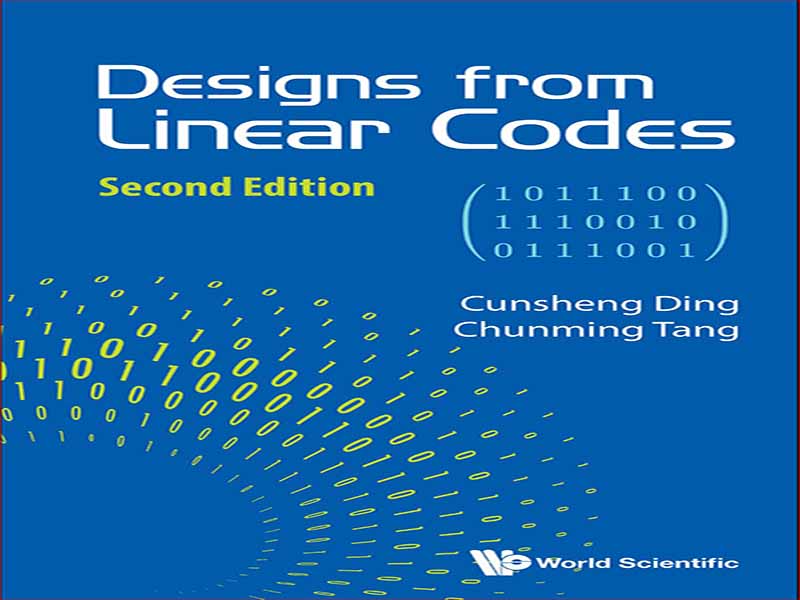- عنوان کتاب: Designs From Linear Codes
- نویسنده: Cunsheng Ding
- حوزه: کدهای خطی
- سال انتشار: 2022
- تعداد صفحه: 221
- زبان اصلی: انگلیسی
- نوع فایل: pdf
- حجم فایل: 5.55 مگابایت
از زمان انتشار اولین ویرایش این تک نگاری، پیشرفتهای زیر در ساخت طرحهای t ترکیبی با کدهای خطی انجام شده است: تعمیم قضیه آسموس-ماتسون برای کدهای خطی بر روی میدانهای محدود [Tang, Ding and Xiong (2019) )]. _ کشف یک خانواده نامتناهی از کدهای MDS نزدیک بر روی میدان های محدود که از یک خانواده نامتناهی از 2 طرح پشتیبانی می کند [Ding and Tang (2020)]. _ کشف یک خانواده نامتناهی از کدهای BCH بر روی GF(22m+1) به طول 22m+1+1 که از یک خانواده نامتناهی از 4 طرح پشتیبانی می کند [Tang and Ding (2021)]. این پیشرفت ها انگیزه اصلی ویرایش دوم این تک نگاری است. قضیه Assmus-Mattson در سال 1969 ایجاد شد و در 50 سال گذشته برای ساختن خانواده های نامتناهی از 2 طرح و 3 طرح استفاده شده است. با این حال، برخی از خانوادههای نامتناهی از کدهای خطی، طرحهای t را پشتیبانی میکنند، اما ویژگی tdesign ساختارهای بروز تعریف شده توسط کدهای خطی را نمیتوان با قضیه آسموس-ماتسون و گروه خودمورفیسم کدها اثبات کرد. در 50 سال گذشته، تقویت قضیه Assmus-Mattson برای کدهای خطی باینری ویژه در Calderbank، Delsarte و Sloane (1991) و چندین آنالوگ قضیه Assmus-Mattson در زمینههای دیگر (به عنوان مثال، طرحهای ارتباطی خاص) مستند شده است. مورالس و تاناکا (2018)]، کدهای بالای Z4 [Tanabe (2000)]، و کدهای رتبهسنجی [Byrne and Ravagnani (2019)]) توسعه داده شدند. قضیه آسموس-ماتسون برای ماتروئیدها که در بریتز، رویل و شیروموتو (2009) توسعه یافته است، شامل قضیه اصلی آسموس-ماتسون به عنوان یک مورد خاص است، اما زمانی که بر روی کدها اعمال شود، به قضیه آسموس-ماتسون تبدیل می شود. قضیه تعمیم یافته آسموس-ماتسون برای کدهای خطی در زمینه های محدود توسعه یافته در تانگ، دینگ و شیونگ (2019) مفید است و موضوع فصل جدیدی در این ویرایش دوم خواهد بود.
Since the publication of the first edition of this monograph, the following advances on constructing combinatorial t-designs with linear codes have been made: _ A generalization of the Assmus-Mattson theorem for linear codes over finite fields [Tang, Ding and Xiong (2019)]. _ The discovery of an infinite family of near MDS codes over finite fields supporting an infinite family of 2-designs [Ding and Tang (2020)]. _ The discovery of an infinite family of BCH codes over GF(22m+1) of length 22m+1 +1 supporting an infinite family of 4-designs [Tang and Ding (2021)]. These advances are the main motivation for the second edition of this monograph. The Assmus-Mattson theorem was developed in 1969, and has been used to construct many infinite families of 2-designs and 3-designs in the past 50 years. However, some infinite families of linear codes do support t-designs, but the tdesign property of the incidence structures defined by the linear codes cannot be proved with the Assmus-Mattson theorem and the automorphism group of the codes. In the past 50 years, a strengthening of the Assmus-Mattson theorem for special binary linear codes was documented in Calderbank, Delsarte and Sloane (1991) and several analogues of the Assmus-Mattson theorem in other contexts (for example, certain association schemes [Morales and Tanaka (2018)], codes over Z4 [Tanabe (2000)], and rank-metric codes [Byrne and Ravagnani (2019)]) were developed. The Assmus-Mattson theorem for matroids developed in Britz, Royle and Shiromoto (2009) does contain the original Assmus-Mattson theorem as a special case, but it becomes the Assmus-Mattson theorem when it is applied to codes. The generalized Assmus-Mattson theorem for linear codes over finite fields developed in Tang, Ding and Xiong (2019) turns out to be useful, and will be the topic of a new chapter in this second edition.
این کتاب را میتوانید از لینک زیر بصورت رایگان دانلود کنید:
Download: Designs From Linear Codes




































نظرات کاربران